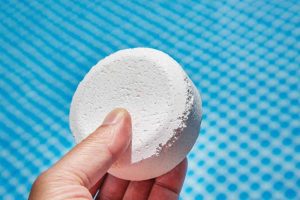Earn 25 credits towards the Pool & Hot Tub Council of Canada’s ( PHTCC’s) Industry Trade Certification Program by completing the quiz.
With the exception of chlorine gas, most inorganic forms of chlorine are base and have a higher pH. These forms of chlorine are more favoured and cost effective when used in geographic areas where the natural fill water is soft. Soft water is low in minerals, which means the water naturally craves calcium and other minerals. Additionally, total alkalinity and pH of soft source waters tends to be lower. It makes more sense to use disinfectants that will be adding what the water craves while also adjusting the total alkalinity and pH upwards.
Trichlor and dichlor are two acidic types of disinfectant and these may be preferred in areas where source water is hard. Hard water means the source is naturally high in calcium and other minerals. Calcium hardness as well as alkalinity and pH may run higher from the tap in these areas. Since trichlor and dichlor contain cyanuric acid stabilizer, they tend to have an effect in lowering alkalinity and pH.
In outdoor pools, the organic forms of chlorine that contain CYA may be preferred because of the presence of a stabilizer that protects against the destruction of HOCl by ultraviolet (UV) sunlight. Again, it is important to note, trichlor and dichlor will leave behind CYA (typically 6 to 7 ppm) per pound of product used in 37,854 L (10,000 gal). The levels of CYA recommended to ensure proper disinfection from chlorine are between 30 and 50 ppm. It is important to test and monitor CYA as extreme high levels may lead to poor disinfection and an interference with total alkalinity readings.
The benefits of chlorine

Chlorine is one of the best choices for disinfecting pool water. It has the ability to effectively kill many disease- causing organisms. This includes Pseudomonas aeruginosa, a common bacteria, which is the culprit of many skin rashes and ear and eye infections, as well as bacteria such as Shigella and E.coli, and Legionnaires’ disease. Chlorine is also effective at inactivating Norovirus and Adenoviruses.
According to the EPA, the required levels for free chlorine residuals in pools is 2 to 4 ppm. In spas/hot tubs, it is 3 to 5 ppm. Chlorine disinfects by disrupting and penetrating the cell wall of threatening organisms. It is also effective at oxidizing non-living waste and works well at leaving a measurable residual to ensure the safety of swimmers as they enter the water. Chlorine is also a great bleaching agent, odour reducer, and the most effective algae-killing agent available. For these reasons, chlorine disinfection remains one of the most cost-effective and sufficient ways to keep pool water clean and sanitary for the protection of bathers. However, it is vital to understand the side effects from the misunderstanding and improper use of chlorine.






